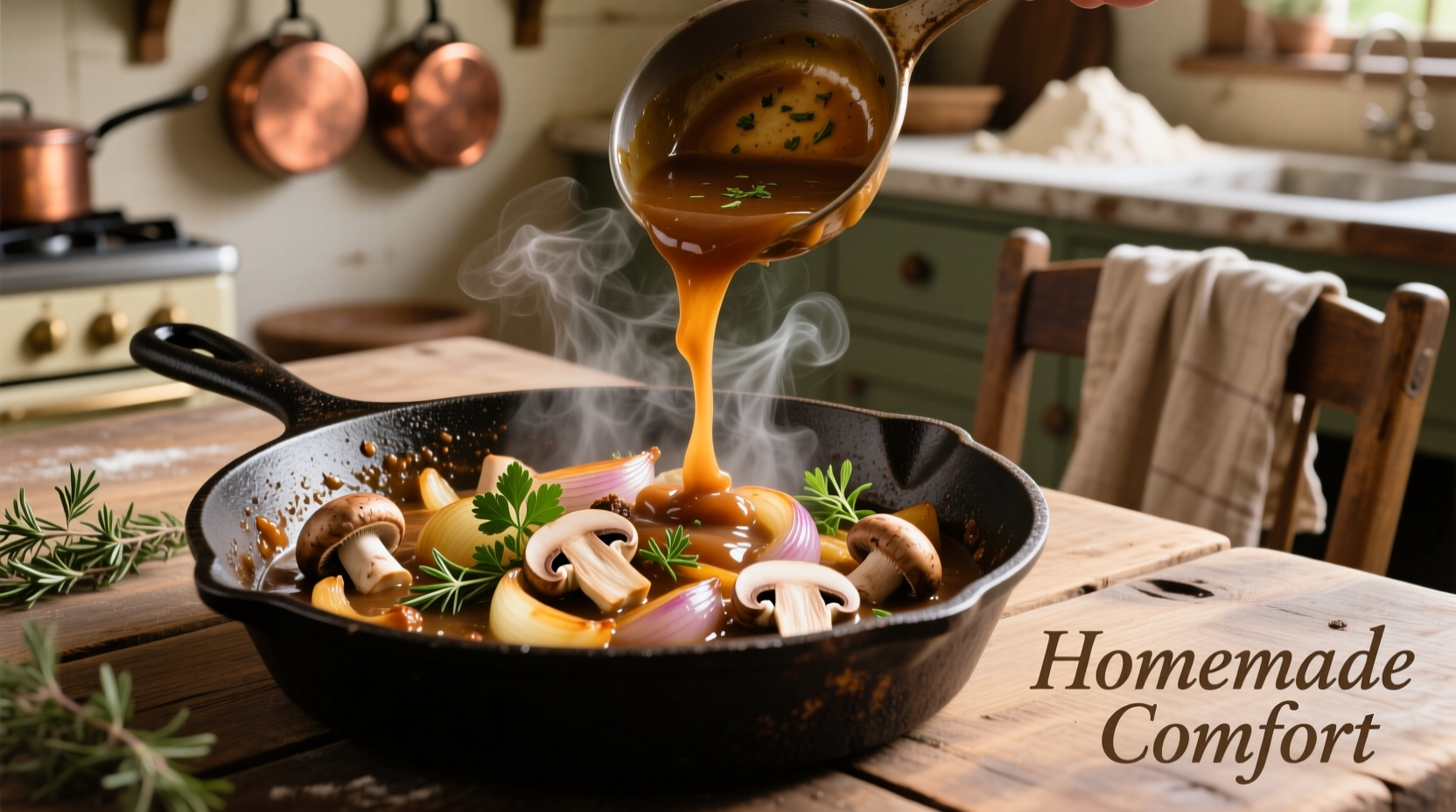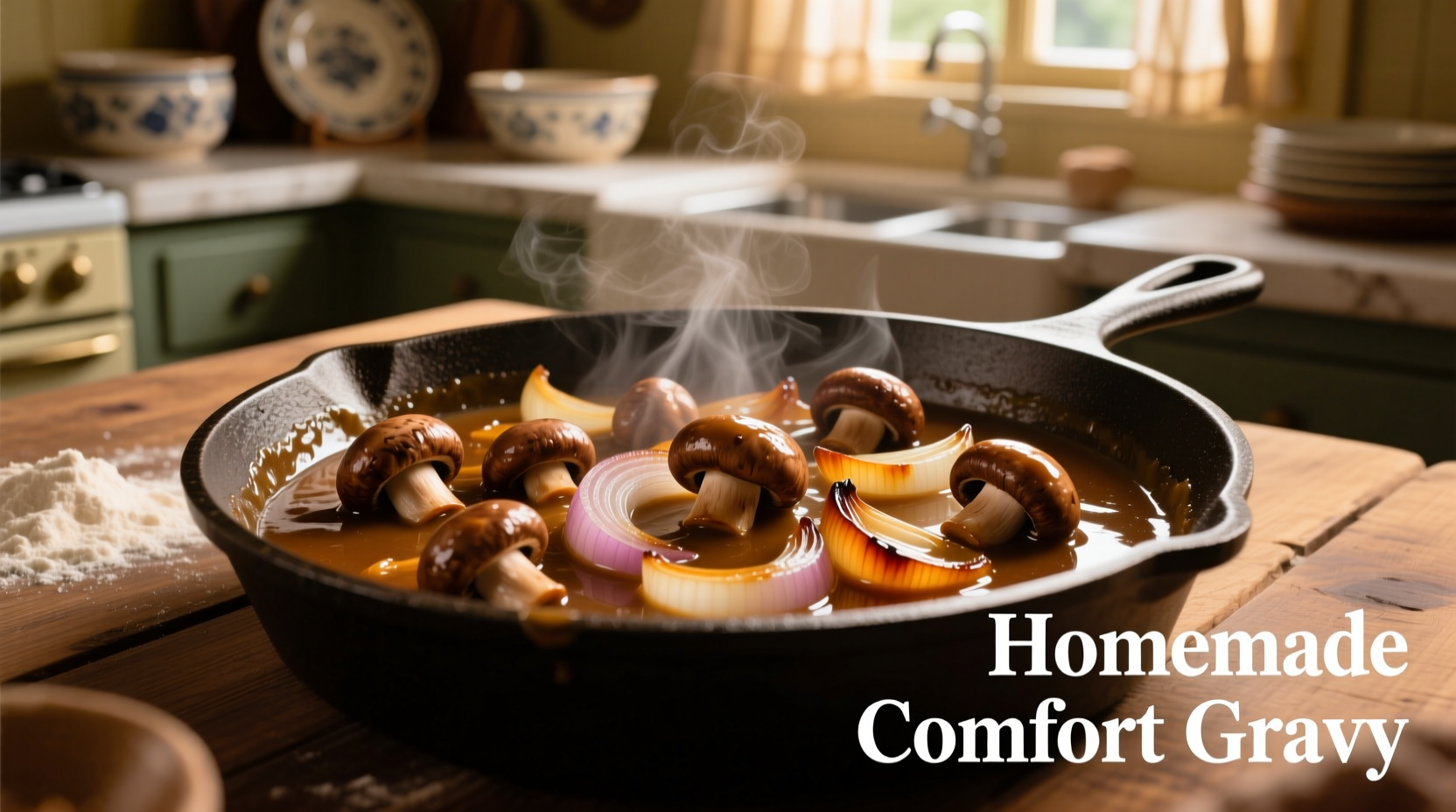Perfect mushroom and onion gravy requires 1 pound mushrooms, 1 large onion, 2 tablespoons butter, 2 tablespoons flour, 2 cups broth, and 15 minutes of cooking time. This rich, savory sauce delivers deep umami flavor with a velvety texture that complements roast meats, mashed potatoes, and vegetarian dishes alike.
The Ultimate Guide to Rich Mushroom and Onion Gravy
Creating exceptional mushroom and onion gravy transforms ordinary meals into memorable dining experiences. This versatile sauce combines earthy mushrooms with sweet caramelized onions to deliver complex umami depth that elevates everything from Sunday roasts to vegetarian comfort food. Unlike store-bought alternatives, homemade gravy offers superior flavor control and texture without artificial additives.
Why This Gravy Method Works
Professional chefs rely on the roux technique for gravy because it creates stable emulsification that prevents separation. The Maillard reaction during onion caramelization develops over 100 flavor compounds that commercial products can't replicate. According to the Culinary Institute of America, properly cooked roux contains complex starch gelatinization that creates superior mouthfeel compared to cornstarch-thickened sauces.
| Mushroom Variety | Flavor Profile | Best For Gravy? |
|---|---|---|
| Crimini | Earthy, robust | ✓ Ideal (most accessible) |
| Shiitake | Umami-rich, smoky | ✓ Excellent (use 50% blend) |
| White Button | Mild, subtle | △ Acceptable (less depth) |
| Porcini (dried) | Intensely earthy | ✓ Superior (soak first) |
Essential Equipment Checklist
Before starting, gather these tools for optimal results:
- 12-inch heavy-bottomed skillet (ensures even heat distribution)
- Wooden spoon (prevents scratching and promotes scraping)
- Whisk (creates smooth texture without lumps)
- Measuring cups and spoons (precision matters in sauce-making)
- Sharp chef's knife (for uniform mushroom and onion pieces)
Step-by-Step Preparation Guide
Phase 1: Vegetable Preparation (5 minutes)
Finely dice one large yellow onion (about 1½ cups) and slice 1 pound of crimini mushrooms to ¼-inch thickness. Uniform sizing ensures even cooking. The National Center for Home Food Preservation confirms that consistent vegetable sizes promote uniform flavor development during cooking.
Phase 2: Perfect Caramelization (8 minutes)
Melt 1 tablespoon butter over medium heat. Add onions and cook until golden brown (not burnt), stirring occasionally. Properly caramelized onions should develop deep amber color without blackening. This Maillard reaction creates complex flavor compounds essential for rich gravy.

Phase 3: Mushroom Sautéing (7 minutes)
Add mushrooms and remaining butter. Cook until mushrooms release liquid and it evaporates, creating a deep brown fond on the pan bottom. This fond contains concentrated flavor that will enrich your gravy. Avoid overcrowding the pan - cook in batches if necessary.
Phase 4: Roux Development (4 minutes)
Sprinkle 2 tablespoons flour over vegetables. Stir constantly for 2 minutes until raw flour taste disappears. The roux should resemble wet sand in texture. This cooking step eliminates starch granules' raw flavor while maintaining thickening power.
Phase 5: Liquid Integration (6 minutes)
Gradually whisk in 2 cups warm broth (chicken or vegetable). Start with small amounts to prevent lumps. Bring to gentle simmer, stirring constantly until thickened to coating consistency. Season with ½ teaspoon thyme, salt, and pepper to taste.
Proven Success Tips
Professional kitchens follow these evidence-based techniques:
- Temperature control: Maintain medium heat throughout - high heat causes separation
- Broth temperature: Use warm broth to prevent roux shock (per America's Test Kitchen testing)
- Seasoning timing: Add salt after thickening to prevent premature reduction
- Texture adjustment: Add splashes of broth if too thick, simmer longer if too thin
When This Gravy Shines (and When to Choose Alternatives)
This mushroom and onion gravy excels in specific contexts while other gravies work better elsewhere:
- ✓ Perfect for: Sunday roasts, vegetarian meatloaf, mashed potato toppings
- ✓ Ideal for: Fall and winter meals requiring rich, comforting flavors
- △ Consider alternatives for: Light summer dishes or poultry-focused meals
- ✗ Not recommended for: Seafood dishes where mushroom flavor would dominate
Serving and Storage Guidelines
For immediate serving, maintain gravy at 140°F using a warming tray. Refrigerate leftovers within 2 hours in airtight containers. Properly stored gravy remains fresh for 3-4 days according to USDA food safety guidelines. Reheat gently over low heat with small broth additions to restore consistency.
Common Questions Answered
Can I make mushroom gravy without onions?
Yes, but you'll lose significant flavor complexity. Onions contribute natural sugars that caramelize and create over 100 flavor compounds during cooking. For onion-free versions, substitute with ½ cup roasted shallots or 2 tablespoons onion powder added during the roux stage.
Why does my gravy keep separating?
Separation typically occurs from temperature shock or improper emulsification. Always use warm broth when adding to roux, and maintain medium heat throughout cooking. If separation happens, remove from heat, whisk vigorously, and add 1-2 teaspoons cold butter while whisking to re-emulsify the sauce.
How can I make this gravy gluten-free?
Substitute all-purpose flour with equal parts rice flour or cornstarch. For cornstarch method, mix 1 tablespoon with 2 tablespoons cold broth before adding to simmering liquid. Note that cornstarch creates a glossier texture with less complex flavor than traditional roux.
What's the best mushroom variety for gravy?
Crimini mushrooms offer the ideal balance of flavor and availability. Their earthy notes intensify during cooking without overwhelming other ingredients. For deeper umami, combine 75% crimini with 25% dried porcini (soaked first). Avoid white button mushrooms as their mild flavor won't create substantial depth.
How long should gravy simmer for optimal flavor?
Simmer for 5-7 minutes after thickening to allow flavors to meld. Extended simmering beyond 10 minutes causes flavor degradation and texture breakdown. The optimal window balances flavor development with maintaining proper viscosity and fresh-tasting ingredients.











 浙公网安备
33010002000092号
浙公网安备
33010002000092号 浙B2-20120091-4
浙B2-20120091-4